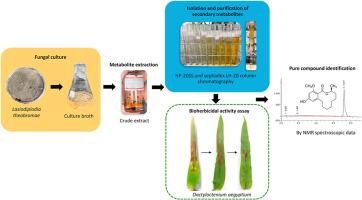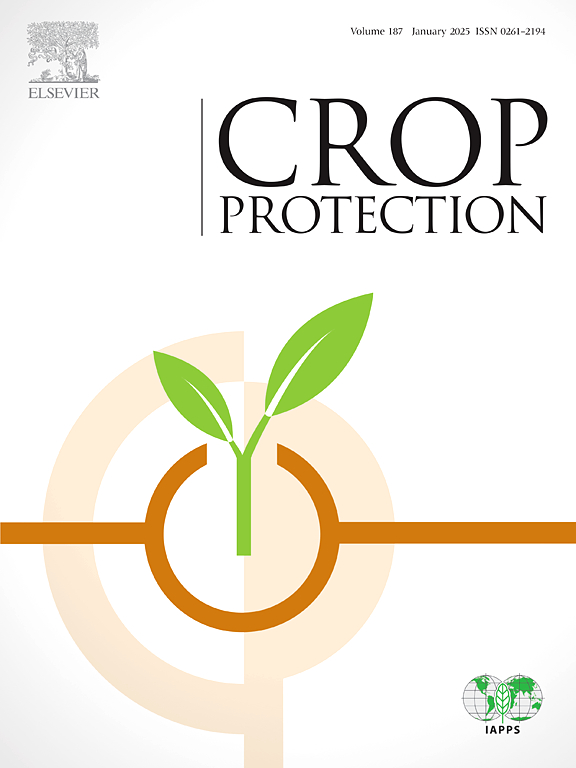Lasiodiplodia theobromae 的次生代谢物对管理窄叶和阔叶杂草的生物杀草作用
IF 2.5
2区 农林科学
Q1 AGRONOMY
引用次数: 0
摘要
除草剂是全世界使用最多的杂草管理方式,但过度使用会对人类健康和环境造成负面影响。利用微生物及其代谢产物进行生物除草是一种很有前景的替代方法。与杂草相关的真菌 Lasiodiplodia theobromae TBRC 15112 能产生广谱的生物分子,具有作为生物除草剂的潜力。在这项研究中,从培养物中提取的 L. theobromae 粗提取物会导致乌脚草(Dactyloctenium aegyptium L.)和三轴菊(Tridax procumbens L.)叶片病变。经过处理的雏菊植株在三天内枯萎倒伏。使用 HP-20SS 柱色谱法,20%、30% 和 40% 丙酮馏分造成的叶片病害分别占埃及雏菊整个叶片面积的 54%、30% 和 34%,而 50% 至 70% 丙酮馏分的严重程度相对较低。利用核磁共振光谱数据,分离并鉴定了八种化合物(包括一种新的代谢物)的结构。其中,五种化合物具有生物杀草活性,即尿嘧啶、酪醇、N-(4-羟基苯基)乙酸、N-(4-羟基苯基)乙酰胺(4HPA)和新的代谢物。我们将这种代谢物命名为 lasiodiplin,它与 alboatrin 相似,但在两个位置上有所不同。耐人寻味的是,酪醇和 4HPA 的混合物对杂草叶片的影响比单独使用纯化合物更大,这表明存在协同效应。在六种测试作物中,粗萃取物也对其中五种作物的叶片造成损伤。我们的研究表明,L. theobromae 粗提取物对狭叶和阔叶杂草具有生物杀草活性。这些数据可为进一步开发基于微生物和微生物产品的生物除草剂铺平道路。本文章由计算机程序翻译,如有差异,请以英文原文为准。

Bioherbicidal effect of secondary metabolites from Lasiodiplodia theobromae for management of narrow-leaf and broad-leaf weeds
Herbicides are the most used form of weed management worldwide but their excessive use could lead to negative impacts on human health and the environment. Biological weed management utilizing microorganisms and their metabolites presents a promising alternative. The weed-associated fungus Lasiodiplodia theobromae TBRC 15112 produces a broad spectrum of biological molecules, and shows potential as a bioherbicide. In this study, L. theobromae crude extracts from cultures caused leaf lesions in crowfoot grass (Dactyloctenium aegyptium L.) and tridax daisy (Tridax procumbens L.). The treated tridax daisy plants wilted and collapsed in three days. Using HP-20SS column chromatography, the 20, 30 and 40% acetone fractions caused leaf lesions covering 54, 30 and 34% of whole leaf areas of D. aegyptium, respectively, whereas relatively lower severities were observed for the 50–70% fractions. Eight compounds, including one new metabolite, were isolated and characterized for their structures using NMR spectroscopic data. Of these, five exhibited bioherbicidal activity, namely uracil, tyrosol, N-(4-hydroxyphenyl) acetic acid, N-(4-hydroxyphenyl) acetamide (4HPA), and the new metabolite. This metabolite, which we named lasiodiplin, is similar to alboatrin but distinct at two positions. Intriguingly, the mixture of tyrosol and 4HPA had a greater effect on weed leaves than pure compounds alone, suggesting a synergistic effect. The crude extracts also caused leaf lesions on five of six tested crops. Our study revealed that L. theobromae crude extracts have bioherbicidal activity on the narrow-leaf and broad-leaf weeds. The data could pave a way for further development of bioherbicides based on microorganisms and microbial products.
求助全文
通过发布文献求助,成功后即可免费获取论文全文。
去求助
来源期刊

Crop Protection
农林科学-农艺学
CiteScore
6.10
自引率
3.60%
发文量
200
审稿时长
29 days
期刊介绍:
The Editors of Crop Protection especially welcome papers describing an interdisciplinary approach showing how different control strategies can be integrated into practical pest management programs, covering high and low input agricultural systems worldwide. Crop Protection particularly emphasizes the practical aspects of control in the field and for protected crops, and includes work which may lead in the near future to more effective control. The journal does not duplicate the many existing excellent biological science journals, which deal mainly with the more fundamental aspects of plant pathology, applied zoology and weed science. Crop Protection covers all practical aspects of pest, disease and weed control, including the following topics:
-Abiotic damage-
Agronomic control methods-
Assessment of pest and disease damage-
Molecular methods for the detection and assessment of pests and diseases-
Biological control-
Biorational pesticides-
Control of animal pests of world crops-
Control of diseases of crop plants caused by microorganisms-
Control of weeds and integrated management-
Economic considerations-
Effects of plant growth regulators-
Environmental benefits of reduced pesticide use-
Environmental effects of pesticides-
Epidemiology of pests and diseases in relation to control-
GM Crops, and genetic engineering applications-
Importance and control of postharvest crop losses-
Integrated control-
Interrelationships and compatibility among different control strategies-
Invasive species as they relate to implications for crop protection-
Pesticide application methods-
Pest management-
Phytobiomes for pest and disease control-
Resistance management-
Sampling and monitoring schemes for diseases, nematodes, pests and weeds.
 求助内容:
求助内容: 应助结果提醒方式:
应助结果提醒方式:


